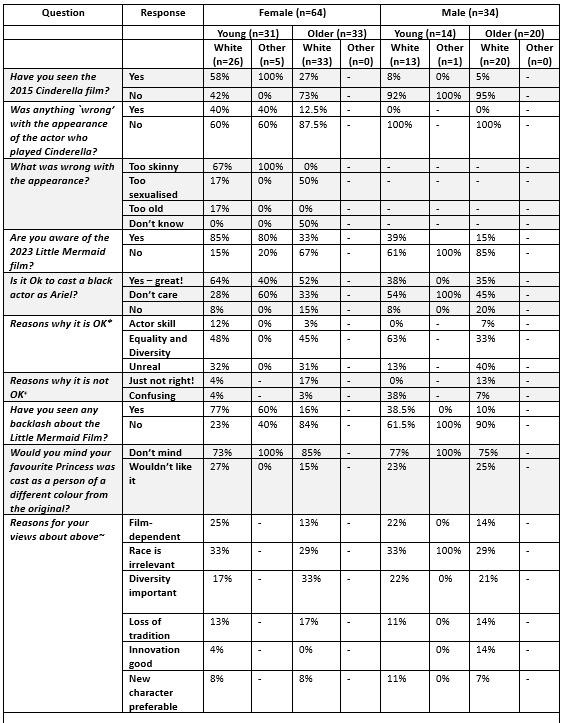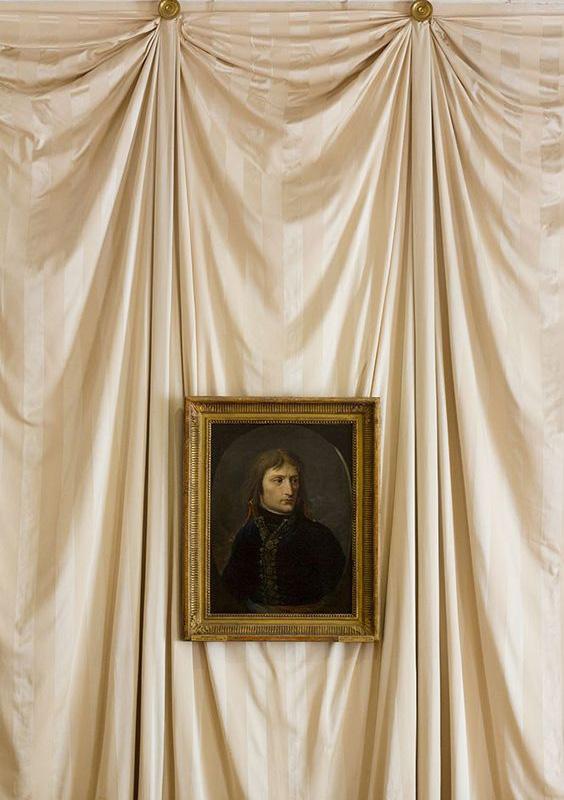
3 minute read
Some Responses When Asked If The Princesses Are Good Role Models:
Reactions concerning the Live-action films are shown in Table Four. Women (particularly younger women) were more likely to have seen the Live-action Cinderella. The majority of all groups did not see anything wrong with the actor’s appearance but where a problem was perceived (only by women – and particularly young women of all ethnicities) the unrealistically slim body of the actor was a key concern. Young white women were especially positive about the casting of a black actor in the Ariel movie with reasons of aiming for equality and diversity being the most common reason across the groups. Older males and females also raised concerns about changing the original character, saying that it ‘just didn’t feel right’. Young males also suggested such a change being confusing for the audience. Younger participants (especially women) were aware of the backlash surrounding the casting of a black Ariel but the majority of the participants in this survey reported they would not mind if their favourite Princesses was cast as a person of a different colour from the original, seeing diversity as important and ethnicity of the actress as generally irrelevant. However, there were some white women and men, of all ages, who were less accepting of this, saying that such changes were associated with a loss of familiarity/consistency with their childhood memories which, for some was upsetting. A number suggested that introducing ethnically diverse new characters (rather than changing the ethnicity of existing characters) would be preferable. Other research has shown that humans can form vivid and detailed memories for movie events (Tang 2016) and that the positive childhood memories associated with escapism of the Disney films specifically elicit positive emotions which are so powerful and long-lasting that they could even be used to facilitate associative learning in adulthood (Knudsen and Thomas). My current results also suggest that for some people these memories are significant, salient and they value them being intact.
These findings are based on a small sample which, unfortunately, was not very ethnically diverse so it is not possible to generalise from these findings. However, they suggest that women, and particularly young women of all ethnicities, are critical of the presentation of Cinderella in the live-action film. Across participants groups there also appears to be a recognition of both the need for diversity but also an acknowledgment of how, by changing the existing characters, there is also for some people, a loss of something to do with the magical ‘essence’ of Disney which is rooted in people’s childhood memories.
Advertisement



Once upon a time, the 'magic' of Disney was as simple as the existence of an animated fairy ..............tale, involving a beautiful Princess, designed to enchant and entertain children and adults alike. Since those early days there have been changes in how films are evaluated. This essay aimed to explore whether the Disney Princesses have kept up with the times in relation to ethnicity and gender roles. Based on my research, including the results of my survey, I have presented evidence that Disney have continuously attempted to adapt to the world around them, in how they present their characters both through the storylines and visually. However, they face a difficult balancing-act of keeping intact a strong Princess brand identity, consistent with the publics’ cherished memories, whilst also responding to current social values.
As outlined in the case study, criticism with the live-action Cinderella was due to Disney keeping the lead actors’ appearance almost too close to the original, giving James the same (unrealistic) waist size as in the animated cartoon. However, when taking the opposite approach with the live-action The Little Mermaid, the backlash also stemmed from the Princess’ appearance, but this time for differing from the original. This highlights the challenges Disney faces when trying to keep up with the times and also navigating the varied and infinite public opinions so easily expressed via social media.
One of the valued core features of Disney’s films is the characters fixed form, both over time and across settings. Disney’s choice to adapt the appearance of Ariel in the live-action film raises questions about how Disney will translate this radical change, and having two different ethnic portrayals of Ariel, into the theme park characters and merchandise, where continuity between film and park characters is a hallmark feature. The possibility of extending this to the other Princesses is also highlighted. My survey results suggest that public reaction to this would be mixed, although generally accepting.
Part of the magic of the Disney Princesses is that they do not represent the times and worlds that we live in; their unreality is part of their escapist charm. However, as viewers are people of all ages, genders, races, cultures, and shape, they should see themselves appropriately represented in the Disney Princesses. A balance of both these aspects is required so we can all live ‘happily ever after’!










